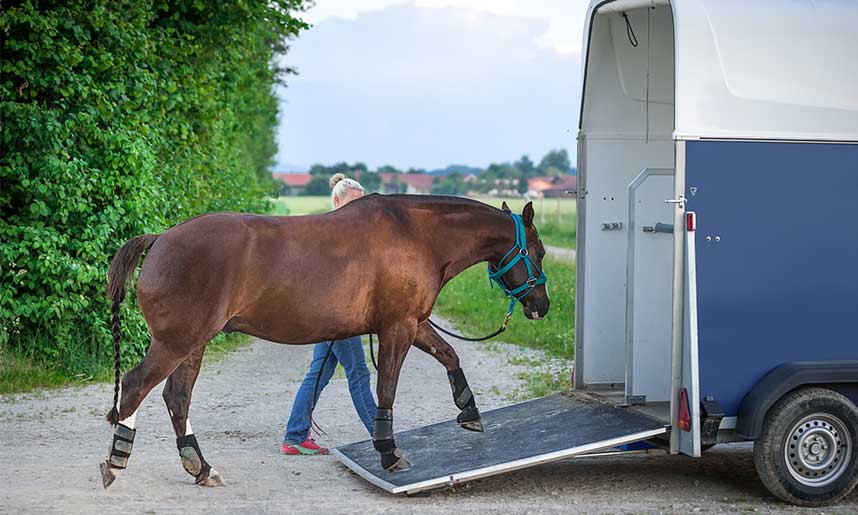Advance planning of your trip
Good preparation is everything when working with horses. To minimize the negative effects of transportation, you'll want to take specific precautions before you even load your horse into the trailer. If you are thinking of leaving for a long trip, it is essential to check the health of your horse before the trip. Make sure your horse is as healthy and fit as possible to start the journey. You may also want to consider having your horse checked out by your veterinarian.
Will you need paper approval?
A paper approval before the trip is often a requirement to cross borders and compete internationally under FEI (Fédération Equestre Internationale) rules. It is vital that your veterinarian assess your horse's health and give it the go-ahead to travel, as well as receive all the necessary documents for the equine health certificate. You will most likely also need proof that your horse has the proper vaccinations issued in your passport to travel and compete.
Be prepared for first aid
No matter how well prepared you are and how fit your horse is to travel, you can never foresee every situation that may come your way. Therefore, we recommend that you carry an easily accessible equine first aid kit. Basic items to have close at hand may include:
- Lantern
- Sterile wraps and bandages
- Filling
- Betadine (povidone-iodine) and antiseptic wound cream
- first aid booklet
- rectal thermometer
- Latex gloves
- Scissors and/or a sharp knife
- Tweezers
- Additional head collar and lead ropes.
- syringes
- A bucket and sponges
Appropriate travel gear
Good preparation also includes thinking about the right travel gear for your horse. In this way, you can travel relaxed and, above all, safe. We have compiled the most important information for you
Legs, tail and other protections
Conditioning your horse from head to toe to prevent unwanted injury during travel is something we encourage riders/horse owners to do when traveling. Transport boots or bandages are commonly used to protect your horse's limbs during travel.
However, keep in mind that if your horse is not familiar with or used to wearing carriage boots, head guards, or tail guards, it may become a problem rather than a solution. Even if some horses need to be handled by padding, others will kick and thrash about with their boots. In the end, it all comes down to knowing what's best for your horse.
If you have decided to continue to use padding for your horse, try acclimating it to protective gear before loading it into the trailer. Also practice your dressing and wrapping skills beforehand. When carriage boots and bandages are not applied correctly, they will slip down your horse's leg, creating uneven pressure on his legs and tendons.
Blankets

Weather conditions must be calculated before your trip. Ensuring your horse has the proper travel rugs will make your journey noticeably more comfortable. This gives you the option of traveling with fly blankets, thin cooling blankets, or thicker wool rugs. It is also recommended that when you stop for a short break on the trail that you make sure to check your horse's body temperature to see if they are sweating due to overheating. Or on the contrary that he is shivering with cold. Depending on how you're handling the weather conditions, you may want to change the blanket throughout your trip. So try to keep all of your general options close at hand for the duration of the trip.
Adequate ventilation conditions
Another common side effect of long-distance travel can be breathing problems. For example, it is quite common for horses unfamiliar with traveling to have a fever due to the harrowing nature of travel and the air quality in the horse area. Frequent rest stops will give your horse the best chance of avoiding such complications.
Improve transport airflow
Try to minimize dust around the trailer as much as possible. Although we recommend that you use some type of bedding to absorb urine, try to use the type of bedding that has minimal dust. The breaks are exceptionally important in maintaining good airflow in the trailer. Professional horse transporters recommend finding a suitable rest stop with adequate shade and quality air every four to six hours. In fact, it's much better if you can plan your route (and your rest stops!) in advance, to ensure there will be adequate space and resources for your horse to make the most of every break.
Take breaks during the trip
During these breaks, you may want to take your horse out and hand walk it for 15 to 20 minutes and, when appropriate, let it graze for a while. During the break, be sure to open the windows and ramps of your trailer to increase airflow at the horse end. For longer trips, it is recommended that horses be unloaded after 12 hours and stabled for at least 6 hours to ensure they clear their airways and have a chance to rehydrate.
night stops
Speaking of longer distances, an overnight stop is always an option to consider when traveling with your equine companions. Getting fresh air, moving and stretching the limbs is essential for the well-being of your horse. Not to mention that giving them the luxury of sleeping in a comfortable position is almost as important as getting the driver a good night's sleep.
Be sure to arrange an overnight stop at a yard you trust to park your horse. Another option commonly used by some commercial horse transporters is to have multiple drivers for the trip to minimize the number of stops and go directly from point A to point B. We humbly recommend and encourage you to find a waypoint to rest your journey. well and make sure your horse feels cooler for the rest of the ride. And you too!
Hydration and Nutrition
Studies show that horses need to eat when they travel, considering that one of the main causes of gastric ulcers is an empty stomach and dehydration. Access to hay can also be used as a distraction if your horse has already been put in a stressful situation during transport. If you are concerned about respiratory problems caused by hay dust particles, hose off or soak the hay in water first to remove that dust and dirt. This will also add a bit of hydration to the hay to make it easier to chew.
How often should your horse drink during the trip?
Even if soaking the hay will help keep your horse hydrated, it is surely not enough. Horses should be offered water every 3 to 6 hours. It is suggested that you supply your own water from home, as your horse can be picky if the water tastes or smells strange to him. If you are unable to bring your own water supply, you may want to try acclimating your horse to flavored water. This can be apple juice or Gatorade to mask changes in the taste and odor of the water to encourage water intake for your horse.
What should you feed your horse?
Your veterinarian will most likely not advise you to feed your horse supplements, electrolytes, or concentrated feed sources for the duration of the trip. The reason for this is that excessive administration of such substances can have an adverse impact on water and electrolyte balance.
If you have found an overnight stop, feel free to feed your horse as you normally would. However, it is very common among horse owners to replace grains and pellets with mash. Unless your horse is used to these, changing its diet while traveling is not recommended. So be sure to discuss your horse's diet with your veterinarian in the planning process.
Our latest Tips for the Camino…
Remember that your first line of defense is to prepare yourself and your horse for the trip well in advance of the trip. And no matter how well you two have traveled, horses need their time to recover after long journeys. So give your horse time to recover from its journey and plan ahead accordingly. Your horse will be really thankful for a full day to recover from a 12 hour ride.
On top of that, you might even want to take a short "practice" ride beforehand. Just to rehearse how everything should be done and see how your horse feels when traveling. Practicing loading and unloading with a horse that is not yet a travel expert will also save you a lot of time on the day of the actual ride.
If you have any further questions or ideas about the trip, feel free to contact our team here. We would love to hear your suggestion and will kindly guide you through your questions.
